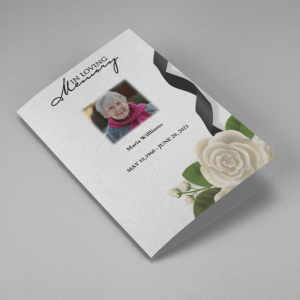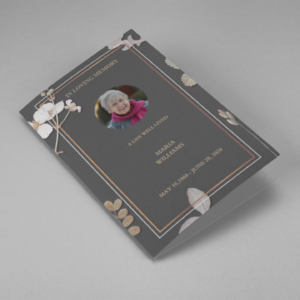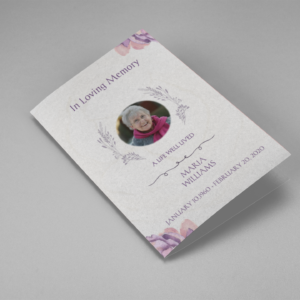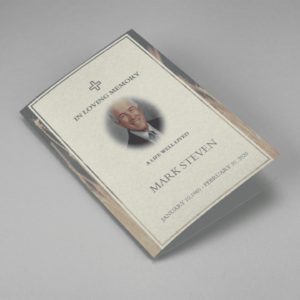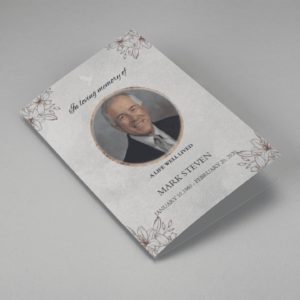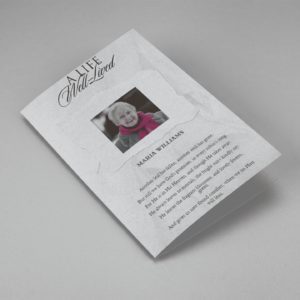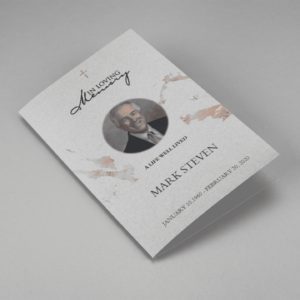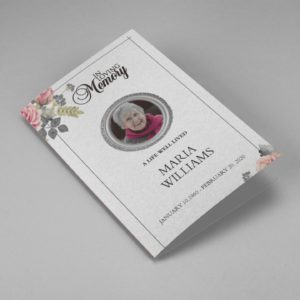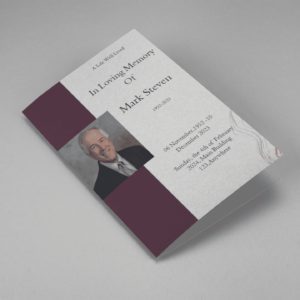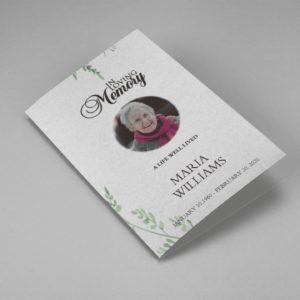A programme for a funeral is a thoughtful document created to honor and remember someone who has passed away. It serves as a guide or itinerary for the funeral service, allowing attendees to follow along and pay their respects. The program includes important details like the name of the deceased, their birth and death dates, as well as information about the service location, date, and time. It may also include religious or spiritual elements, such as prayers, hymns, or readings. Additionally, the program often features a schedule of events, including the order of speakers, musical performances, and any special tributes or eulogies. Sometimes, it includes a brief biography or obituary, highlighting the person’s life and accomplishments. Funeral programs serve as a keepsake for those in attendance, providing a tangible reminder of the person who has passed away and helping to create a meaningful and respectful farewell ceremony.
Invitation To Funeral Programme
An invitation for a funeral program is a thoughtful and respectful way to invite family, friends, and acquaintances to honor and remember the life of a loved one who has passed away. The invitation includes essential details such as the name of the deceased, their birth and death dates, and the date, time, and location of the funeral service. It may also provide information about any specific religious or cultural customs that will be observed during the service.
The invitation serves as a formal request for attendance, extending an opportunity for individuals to offer their condolences and support to the grieving family. It conveys the importance of coming together to pay tribute, share memories, and find solace in the collective mourning. The invitation should be designed with sensitivity and respect, reflecting the tone and style that best represents the life and personality of the departed individual.
Activities Performed In the Funeral Programme
A funeral program typically includes various activities or elements that are performed during the funeral or memorial service. Here are some common activities that may be included:
Welcome and Introduction
A designated person, such as a family member or a religious leader, welcomes the attendees and sets the tone for the service. They may offer opening remarks or provide an overview of the program.
Prayers and Religious Readings
Depending on the religious or cultural traditions, prayers, and religious readings may be included. These can be led by a religious leader or recited collectively by the attendees.
The eulogy or Remembrance Speeches
Family members, friends, or a chosen speaker may deliver eulogies or remembrance speeches to honor the life of the deceased. These speeches often include personal anecdotes, memories, and reflections on the person’s character and impact.
Musical Performances
Songs or hymns can be performed during the service. These can be pre-recorded music played through a sound system or live performances by musicians, choirs, or soloists.
Readings or Poems
Meaningful readings or poems that evoke emotions, provide comfort or offer reflections on life and loss may be included. These can be recited by individuals or read aloud by the officiant.
Special Tributes
Additional special tributes can be incorporated, such as a video or photo montage showcasing the person’s life, a candlelighting ceremony, or a moment of silence to honor their memory.
Closing Remarks
At the end of the service, closing remarks are made to express gratitude to attendees and provide any final thoughts. A final prayer may be offered to offer blessings and comfort.
Needs Of Funeral Programme
The funeral program serves several important needs during the funeral or memorial service. Here are some key needs that a funeral program fulfills:
- Information: The funeral program provides essential information about the deceased, including their name, dates of birth and death, and other pertinent details. It also includes information about the funeral service itself, such as the date, time, and location, enabling attendees to plan and attend the service.
- Order of events: The program outlines the sequence of events and activities that will take place during the funeral service. It helps attendees understand the flow of the ceremony, including any readings, speeches, musical performances, or rituals that will occur. This allows them to participate and engage appropriately.
- Tribute and remembrance: The program often includes a section dedicated to honoring and remembering the deceased. It may feature a brief biography or obituary, highlighting their life achievements, interests, and relationships. This provides attendees with a glimpse into the person’s life and allows them to reflect and pay tribute.
- Keepsake and Memento: Funeral programs serve as tangible keepsakes for attendees. They provide a lasting reminder of the person who has passed away and the funeral service. Family members and friends can take these programs home as a cherished memento and a way to continue honoring the memory of their loved ones.
- Guidance and comfort: The program can offer solace and guidance to grieving individuals. It may include comforting prayers, poems, or inspirational quotes that provide emotional support and reassurance during a difficult time.
Funeral Programme Template
-
Searching for a White Roses And Black Ribbon Funeral Program Template that is easy to print and has a cutting-edge look? White Roses And Black Ribbon Funeral Program Template is the Perfect decision because it measures 8.5”x 11”.
- No Limitation on Content, Edit anything
- Edit anytime – unlimited revisions even after purchased
- Get a printable PDF downloaded to get it printed on your own
-
Searching for a Realistic Burning Candle Funeral Program Template that is easy to print and has a cutting-edge look? Realistic Burning Candle Funeral Program Template is the Perfect decision because it measures 8.5”x 11”.
- No Limitation on Content, Edit anything
- Edit anytime – unlimited revisions even after purchased
- Get a printable PDF downloaded to get it printed on your own
-
Searching for a Bulltongue Arrowhead Funeral Program Template that is easy to print and has a cutting-edge look? Bulltongue Arrowhead Funeral Program Template is the Perfect decision because it measures 8.5”x 11”.
- No Limitation on Content, Edit anything
- Edit anytime – unlimited revisions even after purchased
- Get a printable PDF downloaded to get it printed on your own
-
Searching for a Grey Floral White Tiny Flower Funeral Program Template that is easy to print and has a cutting-edge look? Grey Floral White Tiny Flower Funeral Program Template is the Perfect decision because it measures 8.5”x 11”.
- No Limitation on Content, Edit anything
- Edit anytime – unlimited revisions even after purchased
- Get a printable PDF downloaded to get it printed on your own
-
Searching for a Red Flower Dark Soil Funeral Program Template that is easy to print and has a cutting-edge look? Red Flower Dark Soil Funeral Program Template is the Perfect decision because it measures 8.5”x 11”.
- No Limitation on Content, Edit anything
- Edit anytime – unlimited revisions even after purchased
- Get a printable PDF downloaded to get it printed on your own
-
Searching for a Pink Rose Frame Floral Oval Badge Funeral Program Template that is easy to print and has a cutting-edge look? Pink Rose Frame Floral Oval Badge Funeral Program Template is the Perfect decision because it measures 8.5”x 11”.
- No Limitation on Content, Edit anything
- Edit anytime – unlimited revisions even after purchased
- Get a printable PDF downloaded to get it printed on your own
-
Searching for a Brown and White Classic Funeral Program Template that is easy to print and has a cutting-edge look? Brown and White Classic Funeral Program Template is the Perfect decision because it measures 8.5”x 11”.
- No Limitation on Content, Edit anything
- Edit anytime – unlimited revisions even after purchased
- Get a printable PDF downloaded to get it printed on your own
-
Searching for a Purple Elegant Watercolor Funeral Program Template that is easy to print and has a cutting-edge look? Purple Elegant Watercolor Funeral Program Template is the Perfect decision because it measures 8.5”x 11”.
- No Limitation on Content, Edit anything
- Edit anytime – unlimited revisions even after purchased
- Get a printable PDF downloaded to get it printed on your own
-
Searching for a Cream and Green Photo Obituary Program that is easy to print and has a cutting-edge look? Cream and Green Photo Obituary Program is the Perfect decision because it measures 8.5”x 11”.
- No Limitation on Content, Edit anything
- Edit anytime – unlimited revisions even after purchased
- Get a printable PDF downloaded to get it printed on your own
-
Searching for a Cream Simple Elegant Photo Church Program that is easy to print and has a cutting-edge look? Cream Simple Elegant Photo Church Program is the Perfect decision because it measures 8.5”x 11”.
- No Limitation on Content, Edit anything
- Edit anytime – unlimited revisions even after purchased
- Get a printable PDF downloaded to get it printed on your own
-
Searching for a Grey Classic Minimalist Funeral Program Template that is easy to print and has a cutting-edge look? Grey Classic Minimalist Funeral Program Template is the Perfect decision because it measures 8.5”x 11”.
- No Limitation on Content, Edit anything
- Edit anytime – unlimited revisions even after purchased
- Get a printable PDF downloaded to get it printed on your own
-
Searching for a White Classic Funeral Program Template that is easy to print and has a cutting-edge look? White Classic Funeral Program Template is the Perfect decision because it measures 8.5”x 11”.
- No Limitation on Content, Edit anything
- Edit anytime – unlimited revisions even after purchased
- Get a printable PDF downloaded to get it printed on your own
-
Searching for a Cream Gold Marble Funeral Program Template that is easy to print and has a cutting-edge look? Cream Gold Marble Funeral Program Template is the Perfect decision because it measures 8.5”x 11”.
- No Limitation on Content, Edit anything
- Edit anytime – unlimited revisions even after purchased
- Get a printable PDF downloaded to get it printed on your own
-
Searching for an Elegant Beige Funeral Program Template that is easy to print and has a cutting-edge look? Elegant Beige Funeral Program Template is the Perfect decision because is has a measure of 8.5”x 11”.
- No Limitation on Content, Edit anything
- Edit anytime – unlimited revisions even after purchased
- Get a printable PDF downloaded to get it printed on your own
-
Searching for a White Floral Pro Funeral Program Template that is easy to print and has a cutting-edge look? White Floral Pro Funeral Program Template is the Perfect decision because is has a measure of 8.5”x 11”.
- No Limitation on Content, Edit anything
- Edit anytime – unlimited revisions even after purchased
- Get a printable PDF downloaded to get it printed on your own
-
Searching for a Grey and Burgundy Elegant Funeral Program Template that is easy to print and has a cutting-edge look? Grey and Burgundy Elegant Funeral Program Template is the Perfect decision because is has a measure of 8.5”x 11”.
- No Limitation on Content, Edit anything
- Edit anytime – unlimited revisions even after purchased
- Get a printable PDF downloaded to get it printed on your own
-
Searching for a Creative Watercolor Floral Funeral Program Template that is easy to print and has a cutting-edge look? Creative Watercolor Floral Funeral Program Template is the Perfect decision because is has a measure of 8.5”x 11”.
- No Limitation on Content, Edit anything
- Edit anytime – unlimited revisions even after purchased
- Get a printable PDF downloaded to get it printed on your own
-
Searching for a Soft Green and Grey Minimalist Floral Funeral Program Template that is easy to print and has a cutting-edge look?Soft Green and Grey Minimalist Floral Funeral Program Template is the Perfect decision because is has a measure of 8.5”x 11”.
- No Limitation on Content, Edit anything
- Edit anytime – unlimited revisions even after purchased
- Get a printable PDF downloaded to get it printed on your own
-
Searching for a Green Natural Funeral Program Template that is easy to print and has a cutting-edge look? Green Natural Funeral Program Template is the Perfect decision because is has a measure of 8.5”x 11”.
- No Limitation on Content, Edit anything
- Edit anytime – unlimited revisions even after purchased
- Get a printable PDF downloaded to get it printed on your own
Frequently Asked Question On Programme For Funeral
While making programme for the funeral various types of questions are raised which makes it more difficult . Here we discuss the most asked questions that can be more helpful for you .
What is a programme for a funeral?
A programme for a funeral is a document that outlines the order of events and activities during a funeral service. It provides attendees with information about the service, such as the name of the deceased, date, time, and location.
Why is a funeral programme important?
A funeral program serves as a guide for attendees, allowing them to follow along and participate in the service. It provides essential details about the deceased and the service, offers comfort and support to those grieving, and acts as a keepsake to honor the memory of the departed individual.
What should be included in a funeral programme?
A funeral programme includes the name of the deceased, birth and death dates, service details, order of events, prayers or religious readings, eulogies or remembrance speeches, musical performances, and any special tributes or rituals planned during the service.
How can I create a funeral programme?
To create a funeral program, gather information about the deceased and the service, choose a format and design, include relevant content such as a biography or obituary, select visuals or photos, proofread the program for accuracy, and print copies for distribution.
Can I personalize a funeral program?
Absolutely. Funeral programs can be personalized to reflect the individuality of the deceased. You can include meaningful photos, favorite quotes, personal stories, or unique elements that represent their life and personality.
How many copies of the funeral program should I print?
It is advisable to print enough copies to accommodate all expected attendees, as well as some extras for unexpected guests. It’s better to have more copies than to run out.
Can I involve others in creating the funeral program?
Yes, involving family members, friends, or the funeral director in the creation of the funeral program can ensure that it accurately represents the life and wishes of the deceased. Collaboration can result in a more meaningful and comprehensive program.


